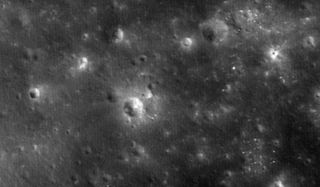On This Day in Space: April 18, 2014: NASA's LADEE probe crashes into the moon
On April 18, 2014, NASA's Lunar Atmosphere and Dust Environment Explorer (LADEE) ended its mission by crashing into the moon.
On April 18, 2014, NASA's Lunar Atmosphere and Dust Environment Explorer (LADEE) ended its mission by crashing into the moon. LADEE had spent seven months orbiting the moon and studying its exosphere, a thin layer of gas that's kind of like an atmosphere, but the molecules are more spread out.
LADEE conducted a lunar dust experiment in which it collected and analyzed the dust particles floating around in the exosphere. This experiment was intended to help NASA solve the mystery behind the faint glow Apollo astronauts reported seeing on the lunar horizon.

— Gallery: NASA's LADEE Moon Dust Mission In Pictures
— The Greatest Moon Crashes of All Time
— NASA's Most Memorable Missions
LADEE discovered neon in the exosphere, but it wasn't enough to account for the glow, and the mystery remains unsolved.
When LADEE ran out of fuel, NASA intentionally crashed it into the lunar surface. It was traveling 3,600 miles per hour (5,800 km/h) during the crash and created a crater almost 10 feet (3 meters) wide.
Get the Space.com Newsletter
Breaking space news, the latest updates on rocket launches, skywatching events and more!
On This Day in Space Archive!
Still not enough space? Don't forget to check out our Space Image of the Day, and on the weekends our Best Space Photos and Top Space News Stories of the week.
Join our Space Forums to keep talking space on the latest missions, night sky and more! And if you have a news tip, correction or comment, let us know at: community@space.com.

Hanneke Weitering is a multimedia journalist in the Pacific Northwest reporting on the future of aviation at FutureFlight.aero and Aviation International News and was previously the Editor for Spaceflight and Astronomy news here at Space.com. As an editor with over 10 years of experience in science journalism she has previously written for Scholastic Classroom Magazines, MedPage Today and The Joint Institute for Computational Sciences at Oak Ridge National Laboratory. After studying physics at the University of Tennessee in her hometown of Knoxville, she earned her graduate degree in Science, Health and Environmental Reporting (SHERP) from New York University. Hanneke joined the Space.com team in 2016 as a staff writer and producer, covering topics including spaceflight and astronomy. She currently lives in Seattle, home of the Space Needle, with her cat and two snakes. In her spare time, Hanneke enjoys exploring the Rocky Mountains, basking in nature and looking for dark skies to gaze at the cosmos.
-
Arc Light Just so you know, the X-15 took off from Edwards AFB under the wing of a B-52 & was airdropped over Delamar Dry Lake, Nevada. The flight to the altitude record wasn't planned, but the rocket engine burned for two seconds longer than expected. The test flight was scheduled to peak at 280,000', but actually reached 314, 750' due to the extra rocket burn time.Reply -
Fourth Root Misleading wording. Bob White did not set the world altitude record on July 17th, 1962. Four Astronauts and two cosmonauts had flown higher prior to his flight. One could say it was the highest manned flight of a winged craft. But that's not the wording that was used.Reply -
DrRaviSharma On this date in 1969, I was part of NASA Apollo TeamReply
Contributed to Experiments in orbit and on Surface of Moon (ALSEP) etc.also trained astronauts
Studied containation on and ouside Spacecraft.
The Moon gave me employment to work for 5 Years on exciting Human Space flight Programs Skylab, Planning of Space Station and Space Shuttle
See My picture taken with Buzz Aldrin in 2009
https://www.space.com/india-moon-landing-not-a-failure.html
I received Apollo Achievement Award from NASA dated July 20, 1969.
Thanks Hanneke Weitering for today's Historic post
Ravi
Dr. Ravi Sharma -
Mergatroid "Allegedly, the moon turns green because of its close proximity to Uranus"Reply
I'm sorry about that. I hear they have been investigating x-rays from the same source. I had no idea. I'll get a doctor to check into it.
Sorry everyone.
Sorry...
